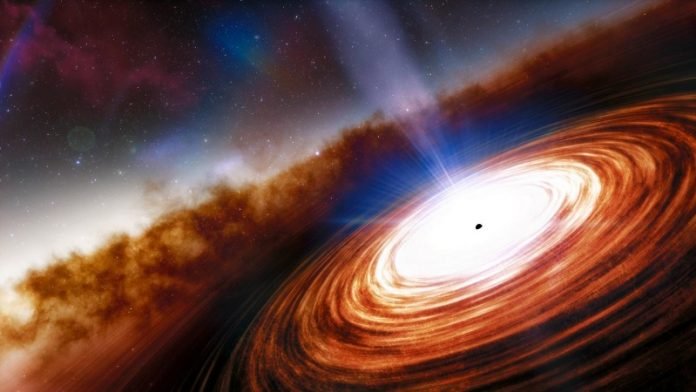
The most distant quasar known has been discovered.
The quasar, observed just 670 million years after the Big Bang, is 1000 times more luminous than the Milky Way.
It is powered by the earliest known supermassive black hole, which weighs in at more than 1.6 billion times the mass of the Sun.
Seen more than 13 billion years ago, this fully formed distant quasar is also the earliest yet discovered, providing astronomers with insight into the formation of massive galaxies in the early Universe.
The result was released today at the January 2021 meeting of the American Astronomical Society.
Quasars, which are powered by the feeding frenzies of colossal supermassive black holes, are the most energetic objects in the Universe.
They occur when gas in the superheated accretion disk around a supermassive black hole is inexorably drawn inwards, shedding energy across the electromagnetic spectrum. The amount of electromagnetic radiation emitted by quasars is enormous, with the most massive examples easily outshining entire galaxies.
Today, an international team of astronomers has announced the discovery of J0313-1806, the most distant quasar known to date.
“The most distant quasars are crucial for understanding how the earliest black holes formed and for understanding cosmic reionization — the last major phase transition of our Universe,” said Xiaohui Fan, study co-author and Regents Professor of Astronomy at the University of Arizona.
J0313-1806 is seen more than 13 billion years ago. As the most distant quasar known, it is also the earliest, being fully formed only about 670 million years after the Big Bang.
The new quasar is more than ten trillion times as luminous as our Sun — meaning that it pours out one thousand times more energy than the entire Milky Way Galaxy.
The source of this quasar’s power is a supermassive black hole 1.6 billion times as massive as the Sun — the earliest black hole currently known to exist in the Universe.
The presence of such a massive black hole so early in the Universe’s history challenges theories of black hole formation as astronomers need to explain how it came into existence when it barely had the time to do so.
Feige Wang, NASA Hubble fellow at the University of Arizona and lead author of the research paper, explains: “Black holes created by the very first massive stars could not have grown this large in only a few hundred million years.”
The observations that led to this discovery were made using a variety of telescopes, including three National Science Foundation NOIRLab facilities — the Víctor M. Blanco 4-meter Telescope at Cerro Tololo Inter-American Observatory, Gemini South, and Gemini North.
Data from the Blanco Telescope, taken as part of the DESI Legacy Imaging Surveys, which are served to the astronomical community via the Astro Data Lab at NOIRLab’s Community Science and Data Center (CSDC), helped to first identify J0313-1806, while Gemini South observations were used to confirm its identity as a quasar.
High-quality spectra from two Maunakea observatories in Hawai’i — Gemini North and W. M. Keck Observatory — were used to measure the mass of the central supermassive black hole.
“The most distant quasars and earliest black holes are important markers in the history of the Universe,” said Program Director Martin Still of the National Science Foundation. “The researchers combined several of NSF’s NOIRLab facilities to make this discovery.”
As well as weighing the monster black hole, the Gemini North and Keck Observatory observations uncovered an extremely fast outflow emanating from the quasar in the form of a high-velocity wind, which is traveling at 20% of the speed of light.
“The energy released by such an extreme high-velocity outflow is large enough to impact the star formation in the entire quasar host galaxy,” said Jinyi Yang, Peter A. Strittmatter postdoctoral fellow of Steward Observatory at the University of Arizona. This is the earliest known example of a quasar sculpting the growth of its host galaxy, making J0313-1806 a promising target for future observations.
The galaxy hosting J0313-1806 is undergoing a spurt of star formation, producing new stars 200 times faster than the Milky Way.
The combination of this intense star formation, the luminous quasar, and the high-velocity outflow make J0313-1806 and its host galaxy a promising natural laboratory for understanding the growth of supermassive black holes and their host galaxies in the early Universe.
“This would be a great target to investigate the formation of the earliest supermassive black holes,” concluded Feige Wang.
“We also hope to learn more about the effect of quasar outflows on their host galaxy — as well as to learn how the most massive galaxies formed in the early Universe.”



